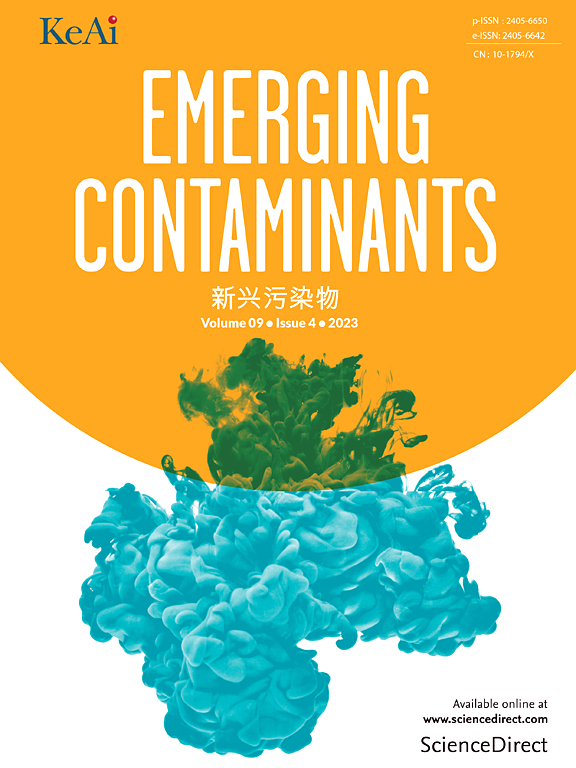Assessing the effects of imidacloprid exposure on the microbiota of Binodoxys communis (Hymenoptera: Braconidae) and gene expression
IF 5.3
2区 环境科学与生态学
Q1 ENVIRONMENTAL SCIENCES
引用次数: 0
Abstract
Imidacloprid is a potent neonicotinoid insecticide that exerts control over cotton aphids. Binodoxys communis is the predominant parasitic threat to cotton aphids, serving as a crucial biological means to control cotton aphids. Imidacloprid has been Sprayed to control cotton aphids, but it also causes toxic effects on the natural enemies of cotton aphids, such as parasitic wasps, Binodoxys communis. However, the sublethal impact of imidacloprid on parasitic antagonists has remained unclear. This study sought to investigate the sublethal effects of imidacloprid on B. communis at the biological phenotype and transcriptional level, as well as the impact of imidacloprid on the microbial composition in the B. communis. Our research indicated that the sublethal dosages of imidacloprid imparted significant biologic adverse impacts on B. communis, including extended larval and pupal stages, as well as reduced parasitism and emergence rates. Following treatment with imidacloprid, transcriptomic analysis identified 1263 significantly differentially expressed genes. These differentially expressed genes were predominantly annotated in metabolic routes, and the annotated genes mainly belong to the fatty acid metabolism pathway, the carbon metabolism pathway, and protein processing in the endoplasmic reticulum pathway. 16S rDNA sequencing results showed significant changes in the composition of the microbial community in B. communis after exposure to imidacloprid. A total of 14 bacteria exhibiting the highest abundance in parasitic wasps were found, and the microbiota abundance of Akkermansia, Bacteroides, Streptomyces, Helicobacter, and Prevotellaceae UCG_001 was noticeably reduced, while Lactobacillus, Escherichia Shigella, Ligilactobacillus, Lachnospiraceae, Rikenellaceae RC9_gut_group, Erysipelatoclostridium, Acinetobacter, Enterococcus, and Aquabacterium were significantly elevated. By evaluating the enrichment pathways of microbial functions, it was found that the microbial functions with significant changes in proportion were mainly annotated to the carbon, fatty acid, and amino acid (aa) metabolic pathways, which was consistent with the transcriptome sequencing results. This finding mirrored transcriptome analysis results. According to transcriptomics analysis and 16S rDNA sequencing data, imidacloprid limits changes in metabolic pathways of B. communis, including fatty acid metabolism, impacting the development and parasitic competence of B. communis. Accordingly, the gene expression linked to detoxification and the cytochrome P450 gene family was significantly elevated at 1 h and significantly declined after three days.
评估接触吡虫啉对Binodoxys communis(膜翅目:蝙蝠科)微生物群和基因表达的影响
吡虫啉是一种强效的新烟碱类杀虫剂,可控制棉蚜。Binodoxys communis 是威胁棉蚜的主要寄生虫,是控制棉蚜的重要生物手段。吡虫啉已被用于控制棉蚜,但它也会对棉蚜的天敌(如寄生蜂 Binodoxys communis)造成毒性影响。然而,吡虫啉对寄生拮抗剂的亚致死影响仍不清楚。本研究试图从生物表型和转录水平上研究吡虫啉对伯氏蓟马的亚致死效应,以及吡虫啉对伯氏蓟马体内微生物组成的影响。我们的研究表明,亚致死剂量的吡虫啉会对共生蝇产生显著的生物不利影响,包括延长幼虫期和化蛹期,以及降低寄生率和出蛰率。使用吡虫啉处理后,转录组分析发现了 1263 个显著差异表达的基因。这些差异表达基因主要注释在代谢途径中,注释的基因主要属于脂肪酸代谢途径、碳代谢途径和内质网途径中的蛋白质加工。16S rDNA 测序结果表明,暴露于吡虫啉后,B. Communis 的微生物群落组成发生了显著变化。共发现 14 种细菌在寄生蜂中的丰度最高,Akkermansia、Bacteroides、Streptomyces、Helicobacter 和 Prevotellaceae UCG_001 的微生物群丰度明显降低、而乳酸杆菌、志贺氏埃希氏菌、ligilactobacillus、Lachnospiraceae、Rikenellaceae RC9_gut_group、Erysipelatoclostridium、Acinetobacter、Enterococcus 和 Aquabacterium 则明显升高。通过评估微生物功能的富集途径,发现比例发生显著变化的微生物功能主要被注释为碳、脂肪酸和氨基酸(aa)代谢途径,这与转录组测序结果一致。这一发现与转录组分析结果相吻合。根据转录组学分析和 16S rDNA 测序数据,吡虫啉限制了共生蝇代谢途径的变化,包括脂肪酸代谢,影响了共生蝇的发育和寄生能力。因此,与解毒和细胞色素 P450 基因家族有关的基因表达在 1 小时内显著升高,三天后显著下降。
本文章由计算机程序翻译,如有差异,请以英文原文为准。
求助全文
约1分钟内获得全文
求助全文
来源期刊

Emerging Contaminants
Medicine-Public Health, Environmental and Occupational Health
CiteScore
10.00
自引率
6.70%
发文量
35
审稿时长
44 days
期刊介绍:
Emerging Contaminants is an outlet for world-leading research addressing problems associated with environmental contamination caused by emerging contaminants and their solutions. Emerging contaminants are defined as chemicals that are not currently (or have been only recently) regulated and about which there exist concerns regarding their impact on human or ecological health. Examples of emerging contaminants include disinfection by-products, pharmaceutical and personal care products, persistent organic chemicals, and mercury etc. as well as their degradation products. We encourage papers addressing science that facilitates greater understanding of the nature, extent, and impacts of the presence of emerging contaminants in the environment; technology that exploits original principles to reduce and control their environmental presence; as well as the development, implementation and efficacy of national and international policies to protect human health and the environment from emerging contaminants.
 求助内容:
求助内容: 应助结果提醒方式:
应助结果提醒方式:


